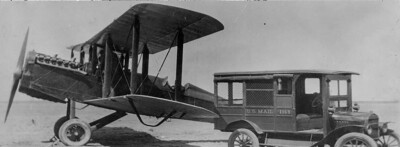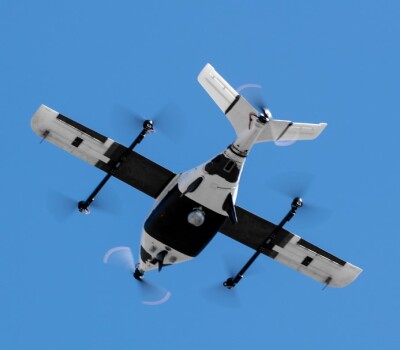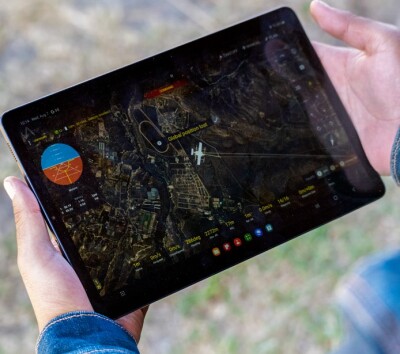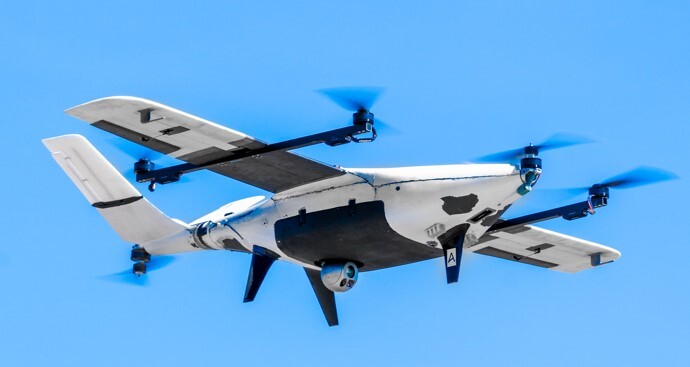As with previous articles, I find it useful to position ourselves at the beginning of crewed aviation history to understand how we are writing the future of uncrewed platforms.
The humble beginnings of the postal delivery service in the US in the  mid-1910s used single-engine biplanes that were piloted in visual meteorological conditions (VFR) flying over routes marked by enormous concrete arrows built on the ground from one side of the North American continent to the next.
mid-1910s used single-engine biplanes that were piloted in visual meteorological conditions (VFR) flying over routes marked by enormous concrete arrows built on the ground from one side of the North American continent to the next.
For someone in 1914 trying to develop a better way to transport letters from the Pacific to the Atlantic, it would be impossible to foresee or design a FEDEX Boeing 777 carrying one million packages, traveling at 700 miles an hour at 35,000 ft of altitude and flying on any weather (IFR).
The same is happening today with delivery drones, as we think we are on the bleeding edge of technology and business models when in reality we are using a single-engine biplane following concrete arrows on the ground.
This week, I had the opportunity to talk to Pedro Meneses, founder and CEO of Aerialoop, the largest drone delivery company and the biggest airline of Ecuador by number of daily flights. Pedro has a master’s degree in aerospace engineering from Embry-Riddle University and is a passionate aircraft designer and manufacturer.
What surprised me about our conversation was his announcement that Aerialoop was getting into the business of live monitoring of remote oil installations. When I questioned his decision to depart from the core business of drone deliveries, he was delighted to explain his reasons and why it is not such a departure after all.
“For a couple of years now we have been delivering thousands of packages a day and growing steadily in number of flights and also packages per flight, but the market in LATAM still takes time to reach the volumes our networks need to break even,” Pedro explained. “Then we received a call from a large oil company in Colombia and they asked us if we could transport a cargo of medical equipment and food while monitoring with a camera and sending live video of their crude distribution network across immense unpopulated areas. It was an incredible challenge due to the lack of communication’s infrastructure along the long pipelines that crisscross the country.”
 Pedro and his team selected their large delivery drone, the ALT-6, for the necessary modifications that would allow a delivery drone to perform the dual mission of real-time monitoring and delivery in remote, cellular communication deprived areas.
Pedro and his team selected their large delivery drone, the ALT-6, for the necessary modifications that would allow a delivery drone to perform the dual mission of real-time monitoring and delivery in remote, cellular communication deprived areas.
“The unique structure of our aircraft and large payload capacity allowed us to integrate a large (6 lbs, 20” x 15” x 1.6”) but efficient low orbit satellite communication antenna inside the fuselage. This eliminates the need to set up costly mesh communication networks in rural and inaccessible areas and enables the UAV to fly anywhere providing live video and central control right off the bat,” Pedro said enthusiastically. “This addition to the fuselage reduced the volume and effective payload somehow but still allows our aircraft to fly 230 kms (143 miles) with only one stop for battery recharge/exchange in an automated station.”
The main problem with conventional satellite antennas is that they require a line of sight to the low orbit satellite, so the aircraft has to turn in a gentler, shallower way, avoiding at all costs losing the connection.
“It took our design team six months to modify and do flight testing of our existing aircraft into what we call the ALT-6 ISR (Inspection, Surveillance and Reconnaissance), a revolutionary platform that can deliver packages to remote oil installations while monitoring the pipeline at the same time,” Pedro said. “We have found that there is a 90% technological overlap between delivery and monitoring in terms of the aircraft, ground infrastructure, fleet management and operational software, therefore our platforms can be slightly modified and still comply with the certifications issued by the civil aviation authorities. This gives Aerialoop a tremendous competitive advantage as we don’t have to create and certify new aircraft all the time. This technology enables global control from any internet-connected device, offering unmatched operational flexibility and reducing costs tenfold compared to conventional drones.”
When the conversation turned to the issue of revenue and profitability, Pedro was really straight forward in terms of the reality of the markets today.
 “We decided to expand into monitoring in order to create a revenue stream that would help the company navigate the turbulent waters of the early funding rounds and the need to grow and be competitive at the same time,” Pedro said.
“We decided to expand into monitoring in order to create a revenue stream that would help the company navigate the turbulent waters of the early funding rounds and the need to grow and be competitive at the same time,” Pedro said.
There is an obvious search for the sweet spot in which the core business of the company does not get affected by a slight deviation into markets with such a high technological overlap.
“We firmly believe that monitoring will make us profitable, and delivery will turn us into a unicorn.” Pedro said, laughing. “The certification requirements for monitoring in remote, unpopulated areas is definitely easier than obtaining permits to fly overcrowded cities, so we can be up and running with this new business model in months, not years. In addition to what we are learning with this new endeavor, we have also developed a concept of hardware-as-a-service in which we will be able to rent out the technology and operating procedures to allow companies in other countries to take advantage of this revolutionary platform. We will now pursue the type certificate with the FAA to penetrate the US market.”
As we can see, the evolution in aviation technology must be closely accompanied by an important flexibility in the business model, so adaptation can happen on both fronts simultaneously. It will be funny to hear that FEDEX will now use their ubiquitous Boeing 777s to monitor the ground as they deliver packages from coast to coast.















Comments